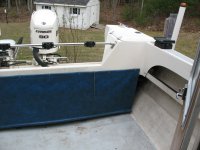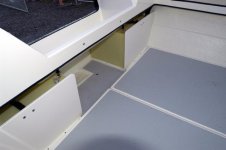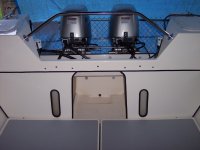Not to take the ease out of easy, but just an additional thing you might want to check/take care of while you're in there (<--- ha ha, that insidious phrase).
(Pardon me if this is all old hat to you and I'm getting too basic.)
So, our hulls (and decks and transoms and some vertical areas) are made with cored construction. Basically, fiberglass is strong but floppy. To make it stiff you either have to make it really thick (heavy!), support it with something like beams or bulkheads, or use a cored panel construction. Cored construction allows larger unsupported areas and is relatively light. It's used a lot in fiberglass boats, although not all of those have cored hulls (ours do).
Think of it like a sandwich: The two bread layers are fiberglass, and the "meat" is either balsa wood, foam, or sometimes plywood or something else. On my boat all the core is balsa (vertical grain). I think most of the coring on 22's is balsa, although I think the pre-1987 boats used plywood, and some of the newer ones have foam in the transom. At any rate, it's all the same principle (not a physicist but as I understand it, once they are bonded together they are under tension and it works like an I-beam).
If the layers become de-bonded from each other, you essentially end up with three floppy boats, not one good one. If water gets into the core area, it gets trapped and de-bonding can happen (balsa can turn to mush, foam can de-bond, etc.). So, it's very important to keep water out of the core. How water gets in? Usually through a penetration of the skin made by a fastener or a piece of hardware. Sometimes fasteners, etc. are put in with "just" caulk and this doesn't tend to work long term, from what I have seen.
So, it's better to take stronger measures, I think.
An extreme way (which I use in some cases but not most) is to completely close out the core by removing it in something like a 6" diameter circle around the hold, and then re-fiberglassing to bring the "lips" of fiberglass together so there is no core (the boat is thinner) in the area of the hole.
The usual way (which I use for nearly everything) is to cut away the coring (by reaching/digging under the top skin with a dental pick, a Dremel bit, or some other method) for a 1/2" or so out from the hole, then fill the whole thing with epoxy (thickened, for strength), then re-drill the fastener hole through the middle of the new epoxy annulus (or if it's a larger open hole like for a rod holder, just dig out the same way then pack the edges with the epoxy - no need to fill the huge hole the rod holder goes through with epoxy just to drill it back out).
Back to the fuel tanks though: If you have the Moeller 18 gallon tanks they will probably have sort of Z-shaped metal hold down brackets that are screwed into the cockpit surface. Likely there will (would have been?) some caulk there but otherwise going into the core. So if it were me, this is when I would check those fastener holes out. And likewise, if I were making any new ones (such as for panel cleats), I would do them the epoxy way.
(If you find wet core around the holes, then I think it's best to dig it all out and repair. On my boat, a few of those holes had a little bit of wet core that came out with just a slightly larger drill; one was larger and I had to excavate a bit. If it gets beyond that point, then there may be some small fiberglass repair to do (because you can only reach/dig so far), but might as well not get into that unless you find something "more."
Sunbeam




